China On My Mind
September/25/2008 Random Thoughts
Because I was working on some important projects during the Olympics, I'm just now getting through all of the DVRs of the event. The incredible spectacle that played out in Beijing is still on my mind. When I visited Beijing in 2006, it was hard to imagine what how the city . . . exploding with mind-boggling growth and clouded with gritty, grimy smog would step into the world spotlight on 08-08-08. I was most curious about the Bird's Nest. For the week during which our PPA delegation visited with Chinese photographers, our accommodations directly overlooked the Bird's Nest construction area. To see the finished structure at the Opening Night ceremonies was magical, considering what the iconic structure shown in the images below looked like only two years earlier.
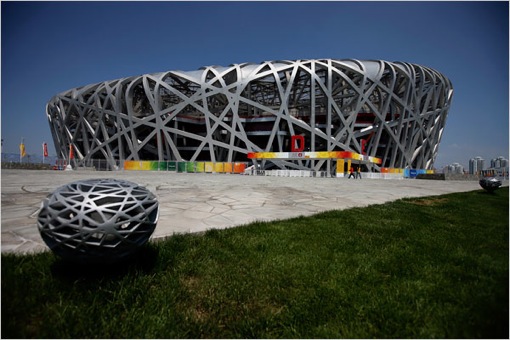
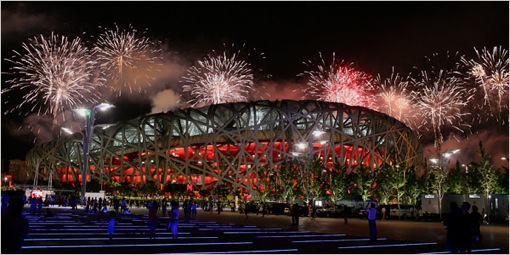
Here is a photo that I took in May, 2006:
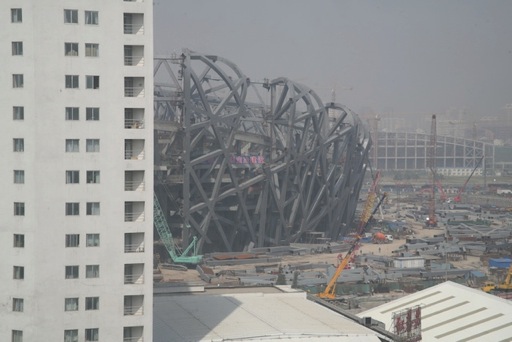
No, this is not a case of my exposure being off. I took this on a "sunny" day, and I actually had to do a few Photoshop tricks to make the image legible. This is the smog that caused so much pre-Olympic concern on the part of athletes and trainers. I'm not sure that a democratic country would have been as successful as the Chinese were in convincing citizens to abandon their cars and shut down belching factories so that the city could be seen in a far better light. Several timely smog-dampening rains also helped to freshen the city. On a smog-free day, Beijing is an incredibly frenetic moving picture, juxtaposed with ageless treasures of art and architecture that can only be fully appreciated through the stillness of the studied human eye or through the aperture of a still camera. Occasionally the TV coverage did justice to the poetry of these contradictions of motion and serenity.
After replaying parts of the Opening Ceremonies several times and marveling at what I saw, I believe the true artistry of that extraordinary choreography was best revealed in some still news photographs that I found on Boston.com. Take a look and see what you think by clicking here. I believe the still camera did a far better job of showing what director Zhang Yimou created: a magnificent melding of people and technology . . . an deliberate metaphor that one cannot fulfill its destiny without the other.
I'm a sports nut, so I devour Olympic Games. Until Beijing, sadly, the most indelible games in my memory was the Munich Olympics, which was overshadowed by an unspeakable act of terrorism. Beijing had it's moment of horror for an American family singled out by a deranged individual. That tragedy aside, I still can't wrap my head around what went on in and around the games, because I suspect that the most important story of this Olympiad will be years in the telling. Like most Westerners who visit there, I see China as a huge question mark. How will this teeming population who, now that they have sampled the bounty that capitalism can produce, and now that they have felt the sense of pride in what they and their leaders have accomplished on the world stage . . . what will they do for an encore? How will they reconcile their modern aspirations with their ancient heritage? How will their potentially volcanic mixture of capitalism-wrapped-in-totalitarianism manage to coexist with the rest of the world?
I would love to visit Beijing again if for nothing more than to see how fast their world has turned and to learn how the photographers I met there are faring in their advance on capitalism. What I observed in 2006 is that most businesses still have at least some government strings that prevent them for achieving self-determination: some definitely more than others. The downtown studio shown below was still operating in "the old way." The plaque on the grand building said: "Top Ten Enterprises of National Photograph Industry," but the government-like interior and the faded portraits in the window said otherwise.
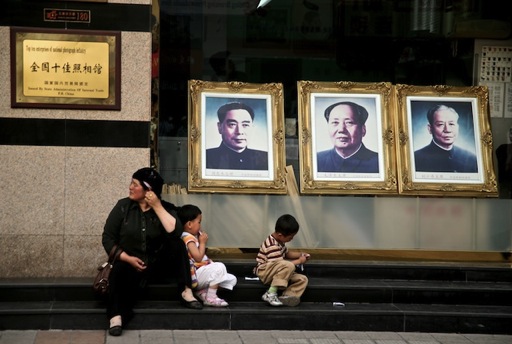
This decidedly modern studio was located in a suburban community built through a cooperative arrangement between the Chinese and Canadian governments. It was thoroughly up to date and housed in a beautifully constructed neo-Craftsman bungalow. Interestly, the overhead burden of the building alone would sink an American business.

Most of the studios looked like and seemingly operated much like the mom-and-pop studios that once dominated our profession.
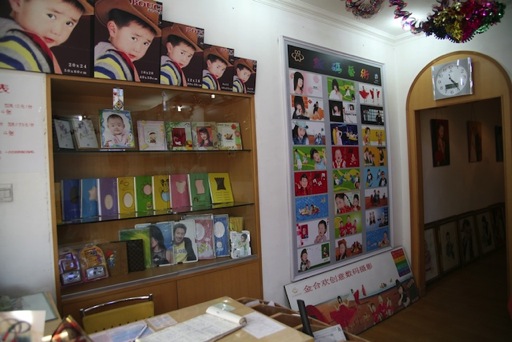
While they were only a few years behind with their digital technology, they face an uphill battle because of exceptionally low prices that dominate their market. I suspect this will continue until middle class citizens can afford to decorate their homes more lavishly and they learn about the decorative potential of photography. When this happens, the dam will burst.
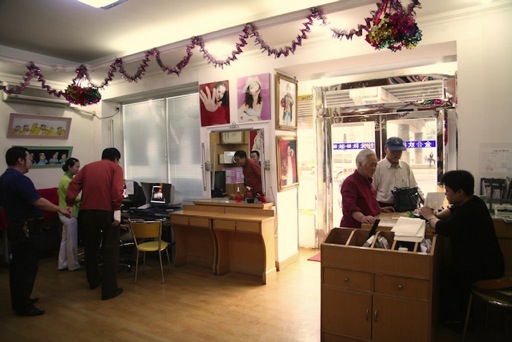
With all of this rolling around in my head, I began looking through some of the photos I took during my two visits to China to find a few that represented what I felt about China in 2006, so that I can use them as a baseline by which to measure the future I might see there on another visit. Nothing really stood out. But what I enjoyed revisiting most were the simple pictures of people going about their business in a remarkable country on the brink . . . a country that provokes thoughts that run in every direction at once. China is often on my mind.
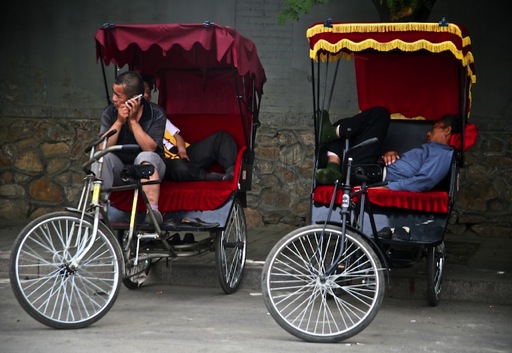
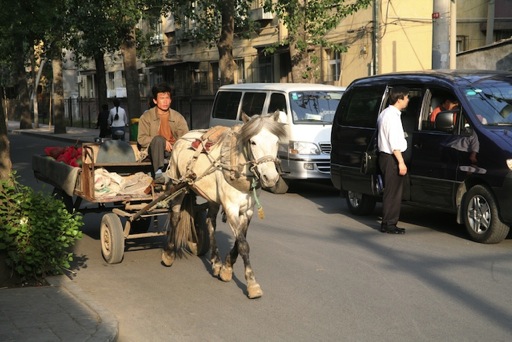
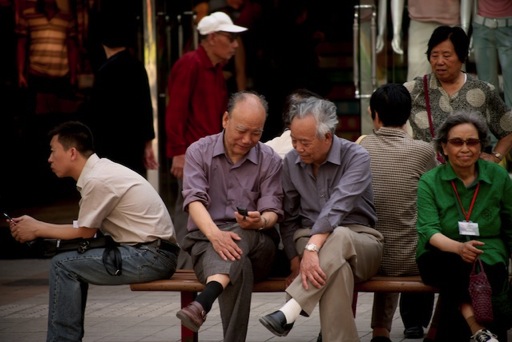


Here is a photo that I took in May, 2006:

No, this is not a case of my exposure being off. I took this on a "sunny" day, and I actually had to do a few Photoshop tricks to make the image legible. This is the smog that caused so much pre-Olympic concern on the part of athletes and trainers. I'm not sure that a democratic country would have been as successful as the Chinese were in convincing citizens to abandon their cars and shut down belching factories so that the city could be seen in a far better light. Several timely smog-dampening rains also helped to freshen the city. On a smog-free day, Beijing is an incredibly frenetic moving picture, juxtaposed with ageless treasures of art and architecture that can only be fully appreciated through the stillness of the studied human eye or through the aperture of a still camera. Occasionally the TV coverage did justice to the poetry of these contradictions of motion and serenity.
After replaying parts of the Opening Ceremonies several times and marveling at what I saw, I believe the true artistry of that extraordinary choreography was best revealed in some still news photographs that I found on Boston.com. Take a look and see what you think by clicking here. I believe the still camera did a far better job of showing what director Zhang Yimou created: a magnificent melding of people and technology . . . an deliberate metaphor that one cannot fulfill its destiny without the other.
I'm a sports nut, so I devour Olympic Games. Until Beijing, sadly, the most indelible games in my memory was the Munich Olympics, which was overshadowed by an unspeakable act of terrorism. Beijing had it's moment of horror for an American family singled out by a deranged individual. That tragedy aside, I still can't wrap my head around what went on in and around the games, because I suspect that the most important story of this Olympiad will be years in the telling. Like most Westerners who visit there, I see China as a huge question mark. How will this teeming population who, now that they have sampled the bounty that capitalism can produce, and now that they have felt the sense of pride in what they and their leaders have accomplished on the world stage . . . what will they do for an encore? How will they reconcile their modern aspirations with their ancient heritage? How will their potentially volcanic mixture of capitalism-wrapped-in-totalitarianism manage to coexist with the rest of the world?
I would love to visit Beijing again if for nothing more than to see how fast their world has turned and to learn how the photographers I met there are faring in their advance on capitalism. What I observed in 2006 is that most businesses still have at least some government strings that prevent them for achieving self-determination: some definitely more than others. The downtown studio shown below was still operating in "the old way." The plaque on the grand building said: "Top Ten Enterprises of National Photograph Industry," but the government-like interior and the faded portraits in the window said otherwise.

This decidedly modern studio was located in a suburban community built through a cooperative arrangement between the Chinese and Canadian governments. It was thoroughly up to date and housed in a beautifully constructed neo-Craftsman bungalow. Interestly, the overhead burden of the building alone would sink an American business.

Most of the studios looked like and seemingly operated much like the mom-and-pop studios that once dominated our profession.

While they were only a few years behind with their digital technology, they face an uphill battle because of exceptionally low prices that dominate their market. I suspect this will continue until middle class citizens can afford to decorate their homes more lavishly and they learn about the decorative potential of photography. When this happens, the dam will burst.

With all of this rolling around in my head, I began looking through some of the photos I took during my two visits to China to find a few that represented what I felt about China in 2006, so that I can use them as a baseline by which to measure the future I might see there on another visit. Nothing really stood out. But what I enjoyed revisiting most were the simple pictures of people going about their business in a remarkable country on the brink . . . a country that provokes thoughts that run in every direction at once. China is often on my mind.


